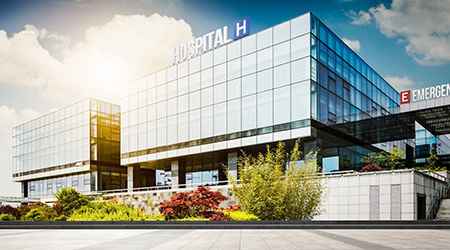Healthcare facilities, including clinics, hospitals, and doctors offices have been uniquely impacted by the pandemic for obvious reasons. Unprecedented demand has been placed on the healthcare system and by extension the buildings where healthcare happens. To complicate the situation further, it is usually the most vulnerable people who occupy these buildings. People who are already sick or people who have other health conditions who should not be exposed to the virus.
As states begin to slowly reopen, you need to brace for more people in your healthcare facilities and more spikes in infection. The traditional methods of keeping your facilities hygienic, like sanitizing surfaces, limiting visitors, requiring masks, and encouraging personal hand sanitizing, are effective, but there is more you can do.
Physical security technology is evolving to keep people in your facilities as healthy and safe as possible during this global pandemic. Now is the time to assess the technology that is beneficial to you now and into the future.
Mobile Credentials for Staff
Mobile credentials take the place of traditional keys or fobs. To unlock an authorized door, for instance, just tap your own smartphone to unlock the door. This limits touching common areas and creates a contactless entry path for authorized personnel.
Mobile credentials are doing double duty since the pandemic. Some are able to give administrators the ability to enable self screening for their users by account or by specific sites. When a credentialed user approaches your door and opens their mobile credential app for the first time each day, they will be prompted to answer one facility safety question. Users will only be able to unlock a door after completing the questionnaire and indicating that they meet health and safety guidelines.
Aside from patients, there are many employees accessing your healthcare facility everyday. The self-screening is a helpful reminder to those credentialed users to take stock of their own health to protect other staff members and vulnerable patients.
Since some healthcare facilities are inherently open to the public, mobile credentials can be even more critical to keep areas that are off limits to the public locked. You can easily block access for the general public, but allow access for authorized users. Our smartphones are always on us, keys and fobs have a tendency to be misplaced. Giving your staff an easy, quick, and contactless way to enter locked spaces will save a lot of headaches.
Data for Contact Reporting
Keeping our healthcare workers healthy is always important, but even more so now. They are on the frontlines of fighting the COVID virus, and we need to keep them safe. New technologies allow you better visibility into who is in your facility, at any given time, and with whom they might have had contact.
Cloud-based physical security solutions are now able to generate large amounts of data and can deliver targeted reports. If a staff member does end up testing positive for COVID-19 you can generate reports listing specific user access events and potential contacts to make sure that any other employees who were exposed can be quarantined to limit any additional spread.
Facility and Personnel Control
Depending on what type of healthcare facility you manage, the number of people visiting right now could have ballooned, or, your facility could be functioning on a severely limited basis. No matter where you fall in that spectrum, cloud physical security gives you the ability to control access to your facility as well as user permissions from anywhere.
There are multiple ways to control access to increase security. With the right physical security solution, you are able to suspend user access automatically until they go through a screening checkpoint. You can change door lock schedules to make sure they are only open to the public for the newer limited hours at your facility or open them longer to adapt to the opposite scenario.
Non-essential employees can have their access revoked all together, or their access credentials limited to keep less people in your facility. In the case of an emergency, total lockdown of the facility can also be triggered.
It is important to consider the realities of this pandemic and the effects on your facility. You’re in charge of more than the traditional safety of the people in your building, now their health must be a top priority as well.
To learn more about protecting your essential healthcare facilities and people, read the guide Protection When It Matters: Security Best Practices for Essential Health Facilities.
